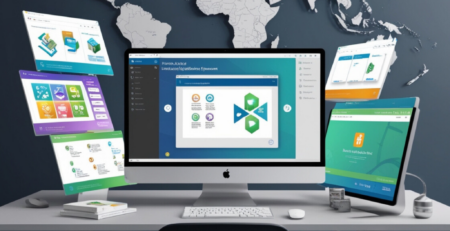How to Measure ROI from Your E-Learning Solutions Effectively
In today’s fast-paced world, e-learning solutions have become essential for businesses looking to train their workforce efficiently. I often hear questions about how to ensure these solutions are truly delivering value. Measuring the return on investment (ROI) of e-learning can feel daunting. However, I assure you it’s not only possible but also crucial for understanding the impact of your training programs. Let’s dive into the best ways to measure ROI from your e-learning solutions effectively.
Understanding ROI in E-Learning Solutions
First, we need to grasp what ROI means in the context of e-learning. ROI measures the financial return you get from your investments compared to what you put in. When we talk about e-learning solutions, we look at how these programs affect productivity, efficiency, employee satisfaction, and, ultimately, the company’s bottom line.
When assessing the ROI of your e-learning solutions, consider the following:
– Cost Savings: E-learning often reduces costs associated with in-person training, including travel, lodging, and venue expenses.
– Time Efficiency: E-learning solutions can shorten the duration of training programs, allowing employees to focus on their core duties.
– Performance Improvements: Increased skills and knowledge typically lead to better job performance, which can positively impact revenue.
– Employee Engagement: Training that is accessible and engaging tends to result in higher retention rates of employees.
Each of these factors contributes importantly to your overall ROI.
Setting Clear Objectives
Before you can measure ROI, you need to define what success looks like for your e-learning solutions. What are your specific goals? Are you aiming to boost sales, improve customer satisfaction, or reduce errors? Clear objectives will set the foundation for how you evaluate the success of your training programs.
– Identify Key Metrics: These might include completion rates, assessment scores, and learning engagement stats.
– Align Training with Business Goals: Your training initiatives should not exist in isolation but should be aligned with broader organizational objectives.
When your objectives are clear, measuring the effectiveness of your e-learning solutions becomes significantly easier.
Data Collection Methods
Next, let’s explore how to collect the data necessary to measure ROI from your e-learning solutions. Data can come from various sources, and it’s essential to gather as much relevant information as possible.
– Surveys and Feedback Forms: After completing a course, asking participants for feedback provides insights into the training effectiveness.
– Performance Tracking: Use metrics like productivity rates before and after training interventions to assess changes.
– Learning Management Systems (LMS): Most e-learning platforms come equipped with analytic tools that can help you track engagement and completion rates.
By implementing diverse data collection methods, you can build a comprehensive picture of the impact of your e-learning solutions.
Analyzing the Data
Once you’ve collected the data, it’s time to analyze it. This phase is critical, as it will help identify what’s working and what may need tweaking.
– Establish Baselines: Understanding the metrics before implementing e-learning solutions is key. If you know your starting point, it’s easier to see progress.
– Identify Trends: Look for patterns in the data. Are there particular courses that lead to higher performance levels? This can provide a roadmap for future training initiatives.
Data analysis is not just about numbers. It’s about interpreting what those numbers mean for your organization.
Calculating Financial Returns
After analyzing the data, the next step is transforming this information into a financial context. This calculation will quantify the ROI of your e-learning solutions.
– Revenue Increases: Identify increases in sales or productivity that can be directly attributed to improved skills from training.
– Cost Reductions: Calculate the savings from reduced turnover, decreased errors, or streamlined processes that your training initiatives enabled.
– Performance Metrics: Consider how improved performance translates into financial gains.
The formula for calculating ROI is:
ROI = (Net Profit / Cost of Investment) x 100
Where Net Profit can be calculated by subtracting the cost of investment from the returns gained through improved performance.
Real-World Examples
There are countless examples showcasing the effectiveness of e-learning solutions. For instance, many organizations report significant gains in productivity and employee knowledge after implementing comprehensive training programs. A recent statistic found that companies can save up to 50% on training costs by utilizing e-learning solutions, along with seeing a 60% increase in employee retention rates.
This data reinforces the idea that investing in e-learning can yield substantial returns when measured properly. Whether it’s improved sales figures, enhanced customer satisfaction, or a decrease in employee turnover, understanding your ROI can illuminate the path forward in your training strategies.
Adjusting Based on Findings
Measuring ROI is not just a one-time task. It’s an ongoing process where adjustments need to be made based on findings.
– Continuous Improvement: Use your insights to refine content and delivery methods. If a course isn’t performing well, don’t hesitate to make changes.
– Feedback Loops: Create mechanisms for ongoing feedback from participants to keep improving your e-learning solutions.
Engagement metrics, learner satisfaction surveys, and post-training performance reviews should all contribute to an iterative process that enhances your education programs.
Communicating Results
Finally, communicating your findings to stakeholders is vital. Sharing the successes and areas for improvement encourages support for future e-learning initiatives.
– Reports and Presentations: Create clear and concise reports on your findings, highlighting key metrics and successful stories.
– Visualizations: Use charts and graphs to represent data in a digestible format. Visual aids can make your presentations more impactful.
When everyone understands the ROI from your e-learning solutions, it creates a fertile environment for further investment in training and development.
Conclusion
Measuring the ROI from your e-learning solutions doesn’t have to be a mystery. With clear objectives, robust data collection, effective analysis, and ongoing adjustments, you can harness valuable insights from your training initiatives.
As we’ve discussed, e-learning solutions can revolutionize the way an organization trains its workforce. By understanding the financial implications and communicating these to stakeholders, you empower your organization to invest wisely in its future.
Whether you are just starting or looking to improve your current programs, I hope this guide provides clarity on the importance of measuring ROI from e-learning solutions. The benefits are immense, and the path to success is entirely within your reach. Let’s commit to embracing this journey together.












Leave a Reply